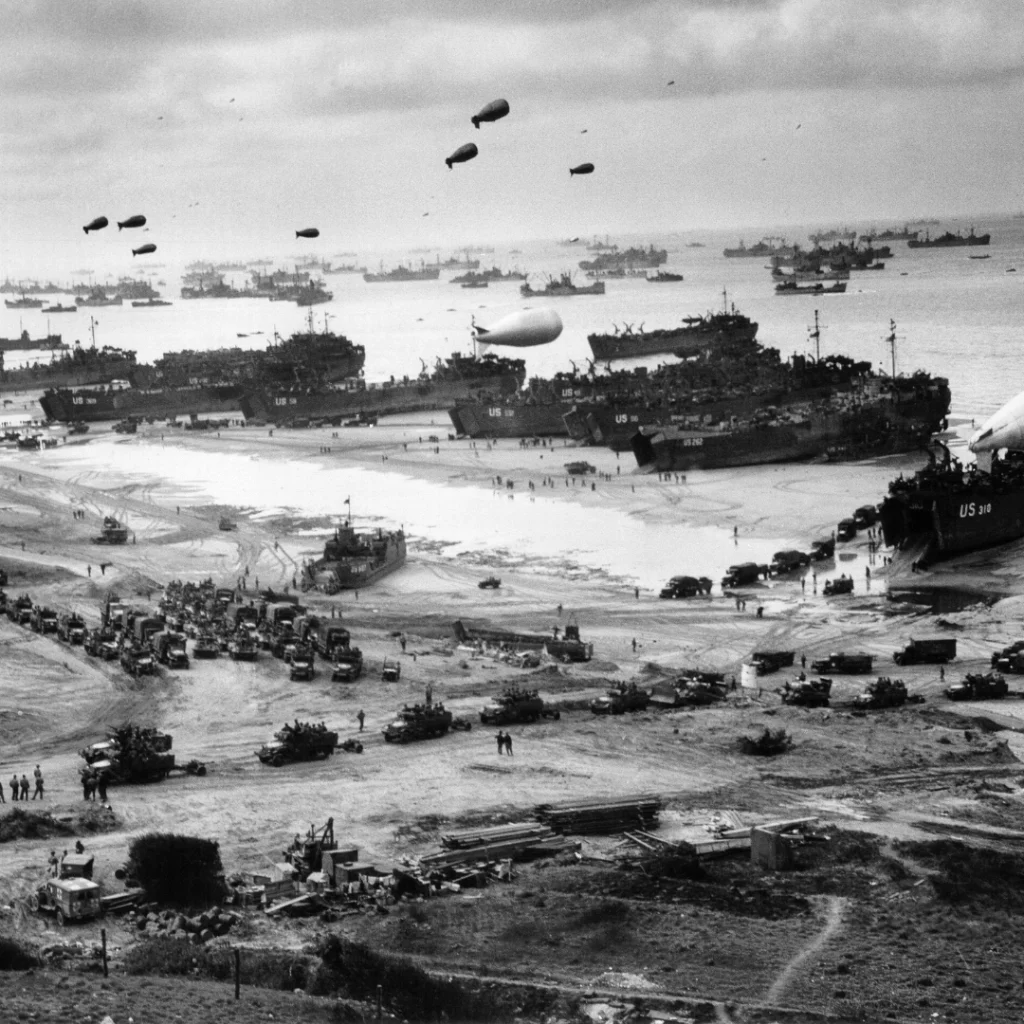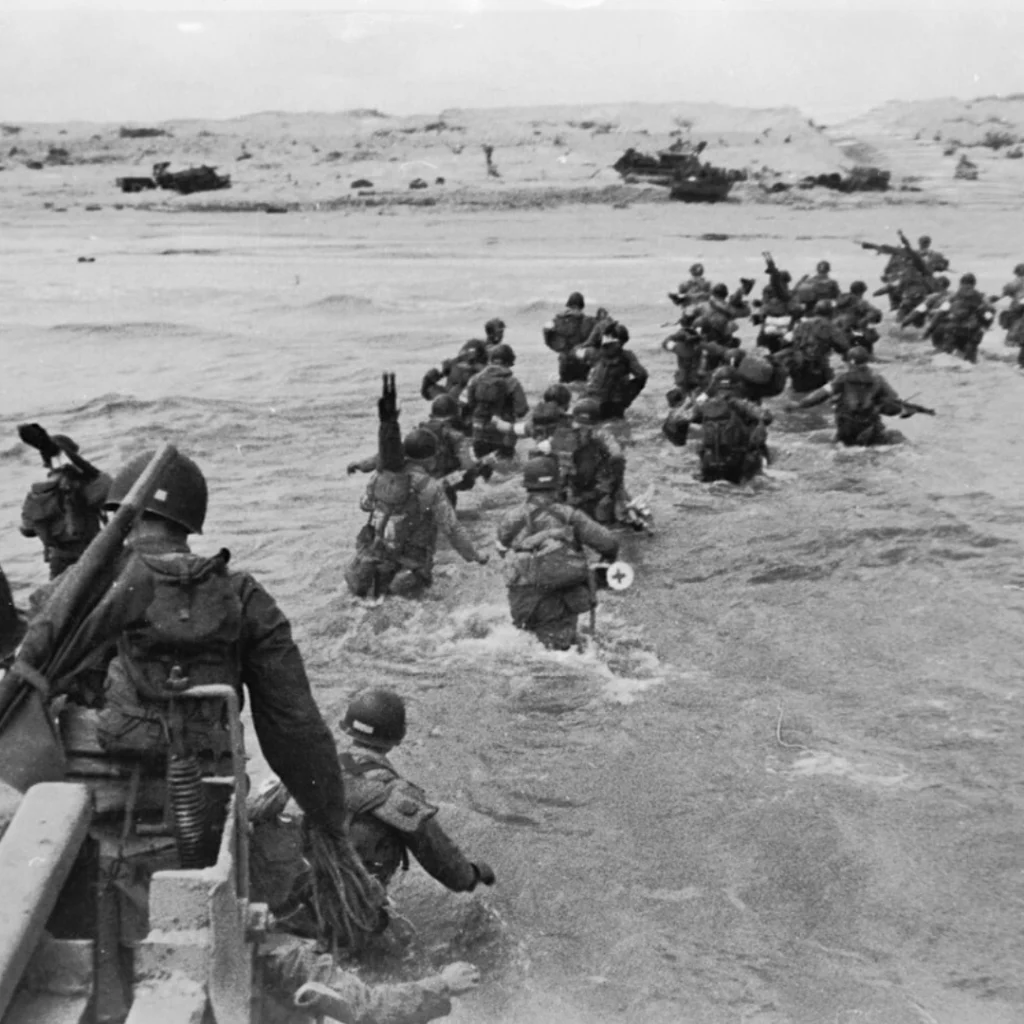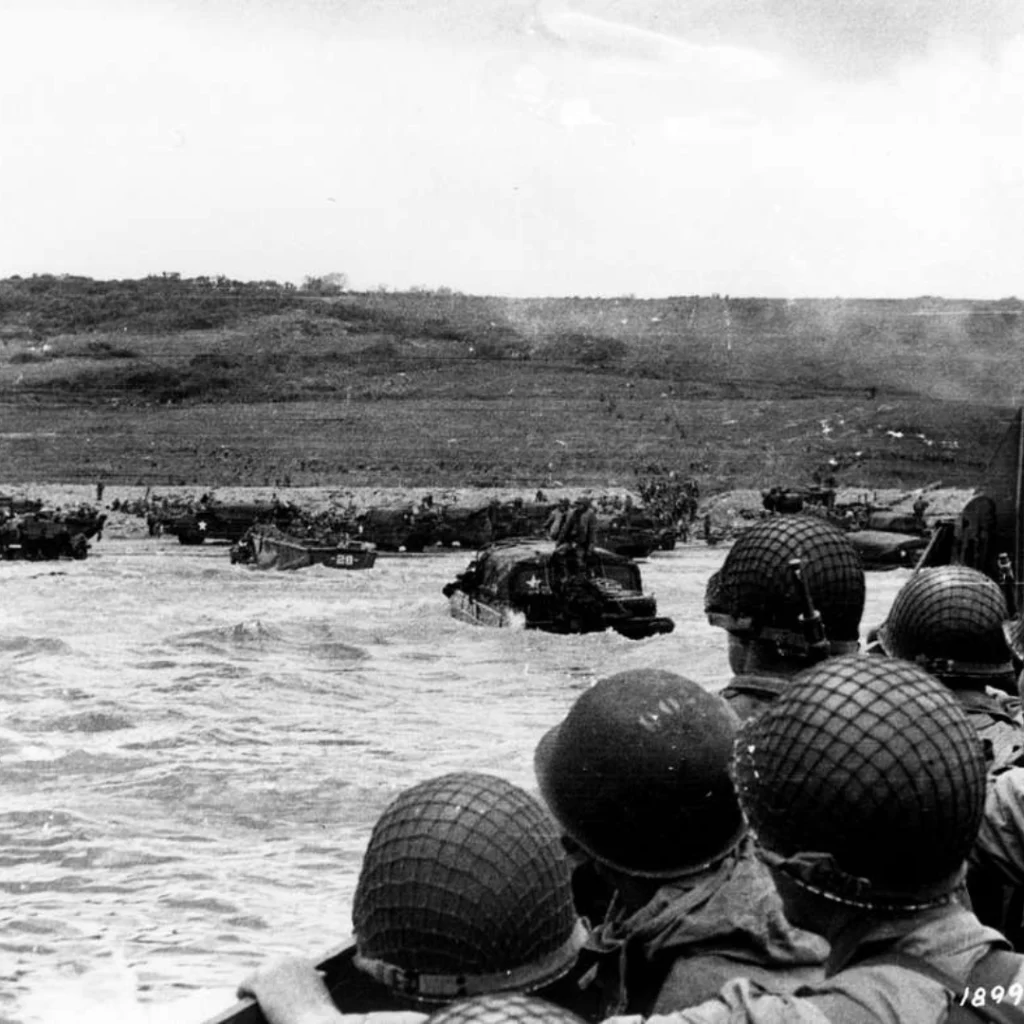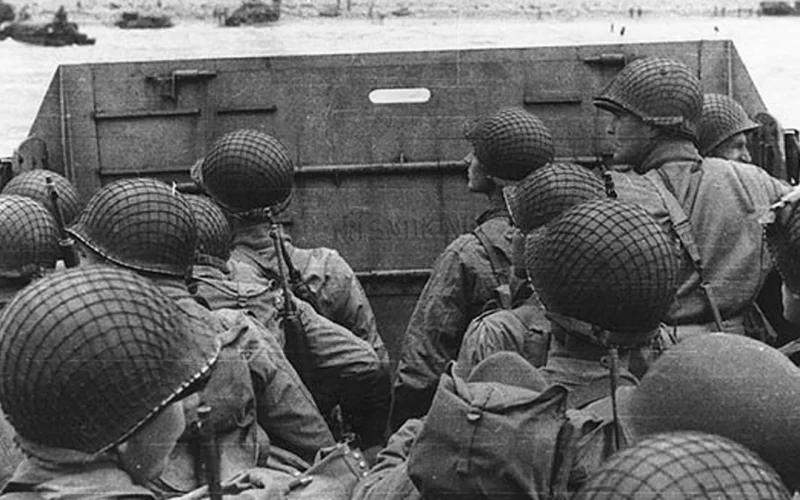In the early hours of June 6, 1944, under the cover of darkness and amidst uncertain weather, Allied forces began the largest seaborne invasion in history—Operation Overlord. The beaches of Normandy, France, became the stage for a military undertaking so vast, so daring, and so strategically complex that it would not only alter the course of World War II but reshape the modern world. Over 150,000 soldiers from the United States, United Kingdom, Canada, and other Allied nations crossed the English Channel to confront the deeply entrenched German defenses, opening a Western front that would eventually lead to the collapse of the Nazi regime.
D-Day was more than a day—it was a culmination of years of planning, intelligence gathering, and international cooperation. It required not only extraordinary bravery on the ground but also remarkable ingenuity in logistics, engineering, and deception. While the iconic imagery of soldiers storming the beaches is etched into public memory, many of the stories, strategies, and sacrifices behind that moment remain less well-known.
This blog explores some of the lesser-known facts about D-Day—details that reveal the true scale, complexity, and human dimension of the operation. From secret decoys and weather gambles to the international forces who came together in the name of freedom, these stories help us understand why June 6, 1944, remains one of the most consequential days in human history.
Table of Contents
1. What “D-Day” Really Means
The term “D-Day” has come to symbolize one of the most pivotal and heroic moments in modern history, but its original meaning is far more utilitarian than dramatic. Contrary to popular belief, the “D” in D-Day doesn’t stand for “doomsday,” “decision,” or “deliverance.” In military terminology, “D-Day” simply denotes the day on which a combat operation is set to commence—a placeholder used in planning when the exact date is not yet determined. This system allows commanders to coordinate complex operations by referencing relative days: D-1, D-2 for days before the launch, and D+1, D+2, etc., for the days following. While the designation was used for many operations, June 6, 1944, became the D-Day due to the scale, impact, and historical weight of the Normandy invasion. Over time, the name has taken on a symbolic significance that far surpasses its technical origins. Today, “D-Day” evokes more than a date—it represents the courage of those who stormed the beaches, the coordination of an unprecedented global alliance, and the turning point in the struggle against tyranny. It is a reminder that even the most unassuming terms can come to embody moments of extraordinary consequence.

2. The Immense Scale of Operation Overlord
Operation Overlord was the largest and most complex amphibious invasion in military history—an undertaking of staggering scale that required years of meticulous planning, coordination, and innovation. On June 6, 1944, over 5,000 vessels—including warships, transport ships, and landing craft—assembled in the English Channel, forming an armada that stretched to the horizon. Supporting this naval fleet were 11,000 aircraft, including bombers, fighters, and gliders, which provided air cover, reconnaissance, and paratrooper deployment. Over 156,000 troops from the United States, United Kingdom, Canada, and a coalition of Allied nations stormed the beaches of Normandy in a synchronized assault across five sectors: Utah, Omaha, Gold, Juno, and Sword. Behind the front lines, over 2 million men and women were involved in logistical support, intelligence, engineering, and medical services. The operation demanded not just brute force, but seamless collaboration between land, sea, and air forces—a feat never before attempted on such a scale. Operation Overlord wasn’t simply a military maneuver; it was an extraordinary human and technological effort that marked the beginning of the Allied liberation of Western Europe.
3. Strategic Deception: Operation Bodyguard
While the Allied success on D-Day required overwhelming force, it also hinged on one of the most elaborate and effective deception campaigns in military history: Operation Bodyguard. Designed to mislead the German high command about the timing, location, and scale of the impending invasion, Operation Bodyguard comprised a web of coordinated sub-operations that extended across Europe. At its core was Operation Fortitude, which used fake radio transmissions, double agents, and a fictitious First U.S. Army Group (FUSAG) under General George S. Patton to convince the Germans that the main assault would land at Pas-de-Calais, the narrowest point between Britain and France. Inflatable tanks, wooden aircraft, and bogus military camps were staged in southeastern England to sell the illusion. Meanwhile, Operation Glimmer and Operation Taxable simulated invasion fleets heading toward Norway and other coastal regions using radar-reflecting chaff dropped by aircraft. This multi-layered deception successfully diluted German defenses, causing the Wehrmacht to hold back key reinforcements from Normandy for weeks after the landings had begun. Without Operation Bodyguard, the element of surprise that gave the Allies a critical edge on June 6, 1944, might have been lost—and with it, the momentum that ultimately led to the liberation of Western Europe.
4. Weather: A Decisive Factor
Weather played a decisive—and nearly disastrous—role in the planning and execution of D-Day. Originally set for June 5, 1944, the operation had to be postponed due to a severe storm system sweeping across the English Channel, bringing high winds, heavy seas, and low visibility. These conditions made it too dangerous for landing craft to approach the beaches and for aircraft to navigate accurately. However, the operation could not be delayed indefinitely; the success of the invasion hinged on very specific environmental factors, including a low tide at dawn, enough moonlight for paratrooper drops the night before, and calm seas for the massive naval armada. These conditions would not align again for several weeks, and a prolonged delay risked German detection and logistical collapse. In a critical moment of judgment, Allied meteorologists—led by Group Captain James Stagg—identified a brief break in the weather on June 6. Supreme Commander Dwight D. Eisenhower made the fateful decision to proceed during this narrow window. Ironically, the poor weather also worked in the Allies’ favor: German commanders, assuming no invasion was possible, were caught off guard. Many senior officers were away from their posts, and German reconnaissance efforts were minimal. In the end, the storm that almost derailed the operation contributed to its success by preserving the element of surprise.

5. A Truly Global Allied Effort
While American, British, and Canadian troops formed the core of the D-Day invasion force, the assault on Normandy was truly a multinational effort—one that underscored the global unity forged in the fight against fascism. Soldiers, airmen, and sailors from more than a dozen nations participated in various capacities, contributing to the success of Operation Overlord. Free French forces played both symbolic and strategic roles, determined to liberate their homeland from Nazi occupation. Polish troops, many of whom had escaped occupied Europe, fought valiantly alongside their Allied comrades, particularly within airborne and armored divisions. Norwegian naval personnel helped escort invasion fleets, while Belgian, Dutch, and Czech units contributed intelligence, resistance support, and specialized skills. Greek forces provided naval support in the Mediterranean, indirectly aiding the European theater, and New Zealanders and Australians, though largely serving in other theaters, played roles in air support, logistics, and planning efforts. This international cooperation not only amplified the military strength of the Allies, but also served as a powerful testament to the widespread resistance against Nazi oppression. D-Day wasn’t just the beginning of the liberation of Western Europe—it was a defining moment of solidarity, where nations large and small stood together to restore freedom and peace.
6. Engineering Ingenuity
Behind the success of D-Day lay an extraordinary feat of wartime engineering. The sheer scale of the invasion required not only overwhelming military force but also innovative solutions to supply and sustain the advancing Allied armies. Since capturing a major port on Day One was impossible, the Allies engineered Mulberry harbors—massive, portable artificial ports assembled from pre-fabricated concrete caissons, floating roadways, and sunken ships. Towed across the English Channel and assembled off the Normandy coast, these temporary harbors allowed thousands of tons of supplies, vehicles, and troops to be offloaded directly onto the beaches. Within days, they handled volumes comparable to fully operational deep-water ports, ensuring a steady flow of reinforcements and materiel into occupied France.
Equally ambitious was PLUTO, or Pipeline Under The Ocean, a project that laid flexible pipelines beneath the Channel to deliver fuel from Britain to the front lines. This innovation eliminated the need to rely entirely on vulnerable fuel tankers and kept Allied tanks, vehicles, and aircraft moving as they pushed inland. Together, Mulberry harbors and PLUTO exemplified the Allies’ ability to combine engineering precision with logistical creativity. These inventions didn’t just support the Normandy invasion—they kept it alive, accelerating the liberation of Western Europe and setting a new standard for military operations.

7. The Human Cost of Victory
The triumph of D-Day came at an immense and sobering human cost. On June 6, 1944, as Allied forces stormed the beaches of Normandy under a hail of gunfire, artillery, and obstacles, approximately 10,000 Allied troops became casualties, including over 4,000 who lost their lives in the first 24 hours alone. The brutal resistance they encountered—especially at Omaha Beach, where American forces faced deadly machine gun nests and steep cliffs—underscored the perilous nature of the mission. Beyond the statistics lie the stories of ordinary individuals who demonstrated extraordinary courage: paratroopers dropped into hostile territory in the dead of night, medics tending to the wounded under fire, and sailors navigating treacherous waters to bring troops ashore. The beaches were littered not only with equipment, but with the price of freedom. For every strategic victory and every liberated town, there was profound personal sacrifice. The human toll of D-Day serves as a lasting reminder that history’s great turning points are often paid for with lives—each one representing a family, a future, and a story of valor that should never be forgotten.
8. Beyond the Beaches: The Battle of Normandy
D-Day marked the opening strike of what would become the Battle of Normandy, a brutal and hard-fought campaign that extended well beyond the initial landings. Spanning nearly three months, from June 6 to late August 1944, the battle saw Allied forces engage in a grinding war of attrition through the hedgerow-filled countryside of northern France. Despite their successful landings, the Allies faced stiff German resistance, including elite Panzer divisions and entrenched defensive positions that turned every village, field, and crossroads into a deadly obstacle. The terrain heavily favored defenders, making the advance slow and costly. By mid-July, over one million Allied troops had landed in Normandy, gradually gaining ground through coordinated offensives such as Operation Cobra, which finally broke the German lines and enabled a rapid Allied breakout into the interior of France.
The victory in Normandy was more than a tactical achievement—it was a strategic watershed in World War II. It shattered the Nazi grip on Western Europe, led directly to the liberation of Paris on August 25, and opened a vital western front that forced Germany into a two-front war it could not sustain. The campaign also demonstrated the power of Allied cooperation and logistics, as troops from numerous nations fought side by side in a coordinated effort. The Battle of Normandy didn’t just free a region; it reignited hope for occupied Europe and set the momentum that would ultimately drive the Allies to victory over Nazi Germany less than a year later.

A Lasting Legacy of Valor, Strategy, and Sacrifice
D-Day was not just a turning point in World War II—it was a defining moment in the modern history of freedom and unity. The success of the Normandy landings was the result of extraordinary bravery on the battlefield, meticulous strategic planning, and a remarkable level of international collaboration. Soldiers from across the globe—many of them barely out of their teens—faced unimaginable odds with courage and conviction, driven by the hope of a world free from tyranny.
Beyond the beachheads and battalions, D-Day tells a larger story: one of human resilience, innovation under pressure, and the willingness of nations to come together in pursuit of a common cause. The untold details—the coded deceptions, the floating harbors, the critical role of weather, and the quiet heroism of individuals—add layers of depth to an already monumental event.
As we look back on June 6, 1944, nearly a century later, we are reminded that history is not just made in grand declarations or sweeping victories, but in the individual choices, sacrifices, and acts of valor that shape the future. By revisiting the lesser-known facets of D-Day, we not only honor the memory of those who served, but also reaffirm the enduring importance of unity, resolve, and the defense of freedom.





